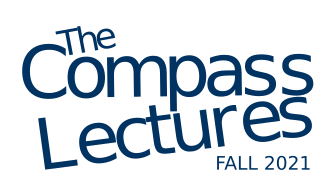
The Compass Lecture Series is a collection of research talks given by Berkeley physical sciences faculty or PhD candidates who are about to graduate. These talks are unique in the Berkeley Physics Department in that they are designed for an undergraduate audience. The goal of the lecture series is to introduce undergrads to as many areas of research as possible using language and physics concepts they can understand. Undergraduates interview and introduce the speakers and manage the question-and-answer period that follows the talk. The lectures take place on the Fridays listed below at 3:10 PM (AKA 3PM Berkeley time) in 375 Physics North.
The Fall 2021 Lectures:
Lecture 1 (Friday Oct. 1, 2021):
The (fractional) quantum Hall effect and exotic particles
Lecture 2 (Friday Oct. 8, 2021):
Dirty Fireballs, Orphan Afterglows, and a Cow: The Landscape of Stellar Death
Lecture 3 (Friday Oct. 15, 2021):
Path Integrals: Summing over a whole new infinity
Lecture 4 (Friday Oct. 22, 2021):
How biology, chemistry, and geology meet to tell a story about climate
Lecture 5 (Friday Oct. 29, 2021):
What happens in photoexcited materials in one trillionth of a second?
Lecture 6 (Friday Nov. 5, 2021):
Planetary Diversity: From diamond planets to hot Jupiters
Lecture 7 (Friday Nov. 12, 2021):
Symmetry Discovery Using Deep Learning
Lecture 8 (Friday Nov. 19, 2021):
Lecture 9 (POSTPONED TO NEXT SEMESTER):
Probing the standard model using atom interferometry
The (fractional) quantum Hall effect and exotic particles
Tessa Cookmeyer, PhD Candidate in Physics
Date & Time: Friday, October 1, 2021, 3:00 pm – 4:00 pm
Location: 375 Physics North
Talk Description: The Standard Model is like the periodic table for particle physicists—it describes the particles (like quarks, electrons, photons) that are the building blocks for everything we see. You might think that all possible particles can be found in the Standard Model, then, but you’d be wrong!! When we combine many electrons, protons, and neutrons together to make solid materials, we find particles that are fundamentally different from every Standard Model particle. We’ll talk through the story of the fractional quantum Hall effect and how it demonstrates the existence of these new particles, and we’ll discuss recent work that points to materials where we might find similar (but yet unseen) new particles.
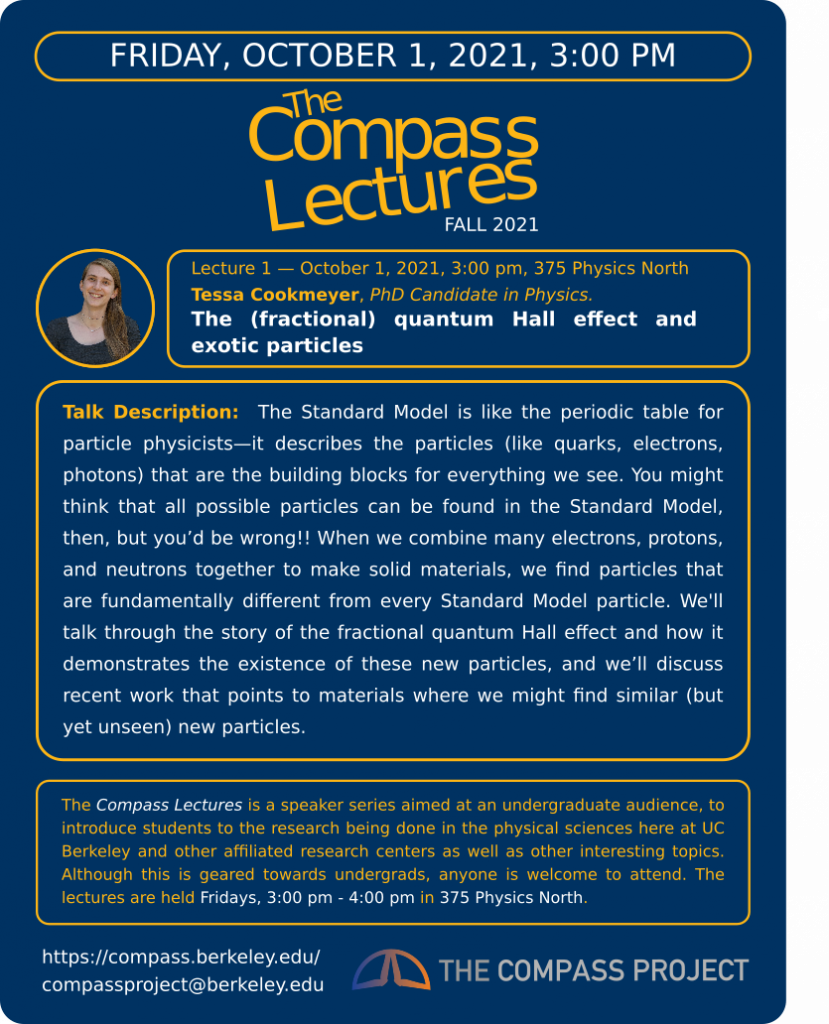
Dirty Fireballs, Orphan Afterglows, and a Cow: The Landscape of Stellar Death
Anna Ho, Postdoctoral Researcher in Astronomy
Date & Time: Friday, October 8, 2021, 3:00pm – 4:00pm
Location: 375 Physics North
Talk Description: The fate of a star — how it lives its life, how it dies, and the corpse it leaves behind — depends primarily on its mass. High-mass stars explode as a supernova and leave behind a neutron star or a black hole. In rare cases, a powerful relativistic jet is launched by the newly formed black hole, appearing as a gamma-ray burst (GRB). There have been thousands of GRBs discovered, traditionally by satellites designed to detect gamma rays. But recent discoveries by observatories at optical wavelengths hint at diverse outcomes that are invisible to GRB satellites: jets that are choked inside the star, jets that are directed away from Earth, and jets that have different compositions. In my work, I have been searching for relativistic explosions using a network of robotic telescopes around the world and in space.
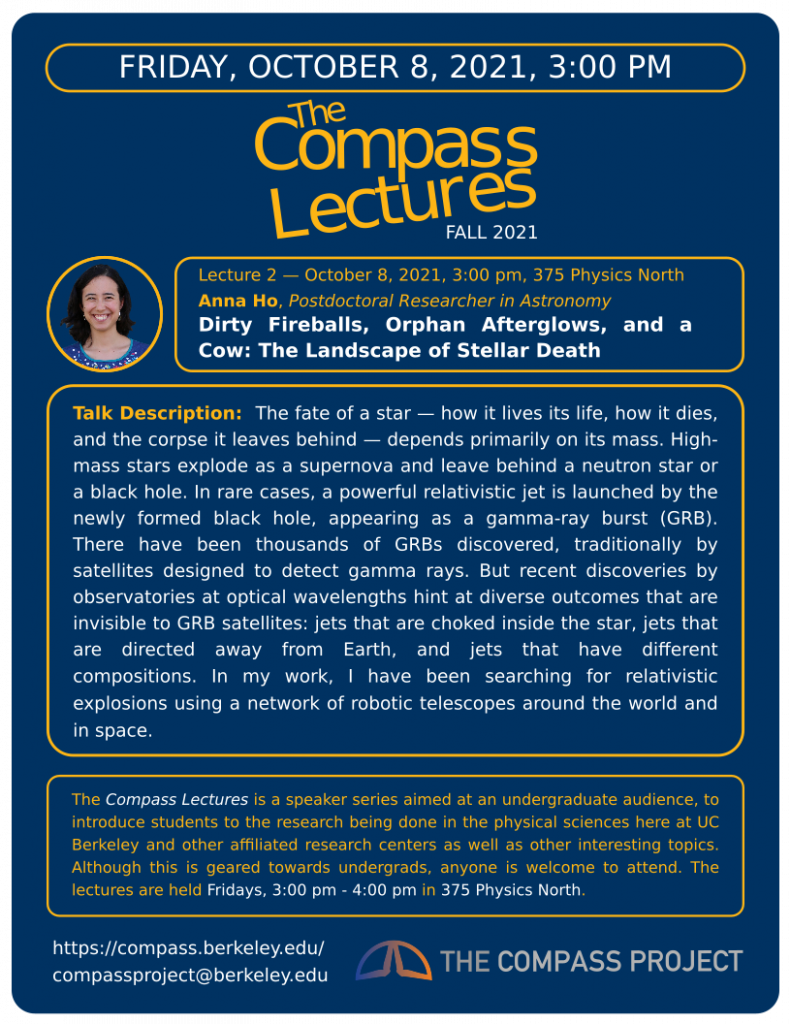
Path Integrals: Summing over a whole new infinity
Ivan Mauricio Burbano Aldana, Graduate Student in Physics
Date & Time: Friday, October 15, 2021, 3:00pm – 4:00pm
Location: 375 Physics North
Talk Description: We first learn to add. Then to add over a finite number of points. Then to add over an infinite, but discrete, number of points! But then we need to add over the continuum of points on a line. We even need to add over the points in a plane, in a sphere, in a volume, in spacetime! What comes next? Adding over an infinite number of dimensions, over fields. In this lecture we will explain the beauty and versatility of the path integral. At the end of it all, it is the thread that unites the solid state, the statistical, the quantum, and mathematics, to name a few.
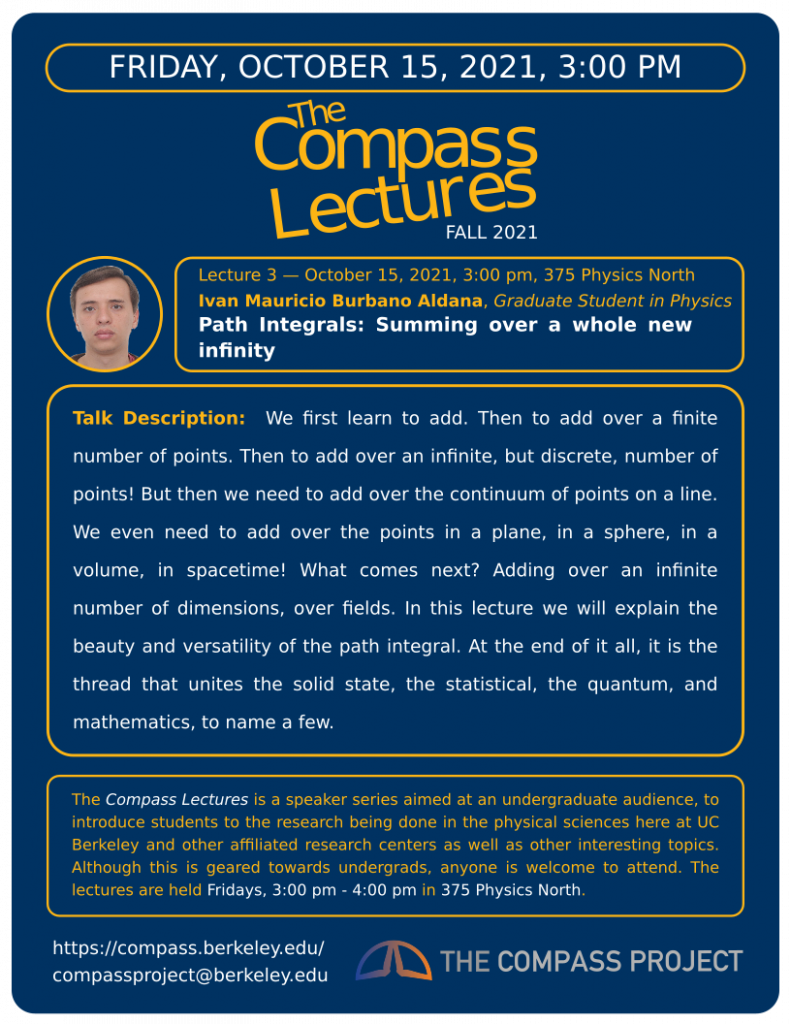
How biology, chemistry, and geology meet to tell a story about climate
Rebekah Stein, Postdoctoral Researcher in Earth and Planetary Science
Date & Time: Friday, October 22, 2021, 3:00pm – 4:00pm
Location: 375 Physics North
Talk Description: Biogeochemistry is a study of the intersection of biology, geology, and chemistry. Often chemistry as recorded in plants and animals can give us insight into the past and present, as these organisms interact directly with the atmosphere, biosphere, hydrosphere, and geosphere. I will present on a multitude of chemical tools in modern and ancient (fossil) plants and soils I have used in my research. These tools allow us to understand ancient climate as well as the dynamic impacts of modern climate change on land ecosystems, and have ancient and modern environmental science applications.
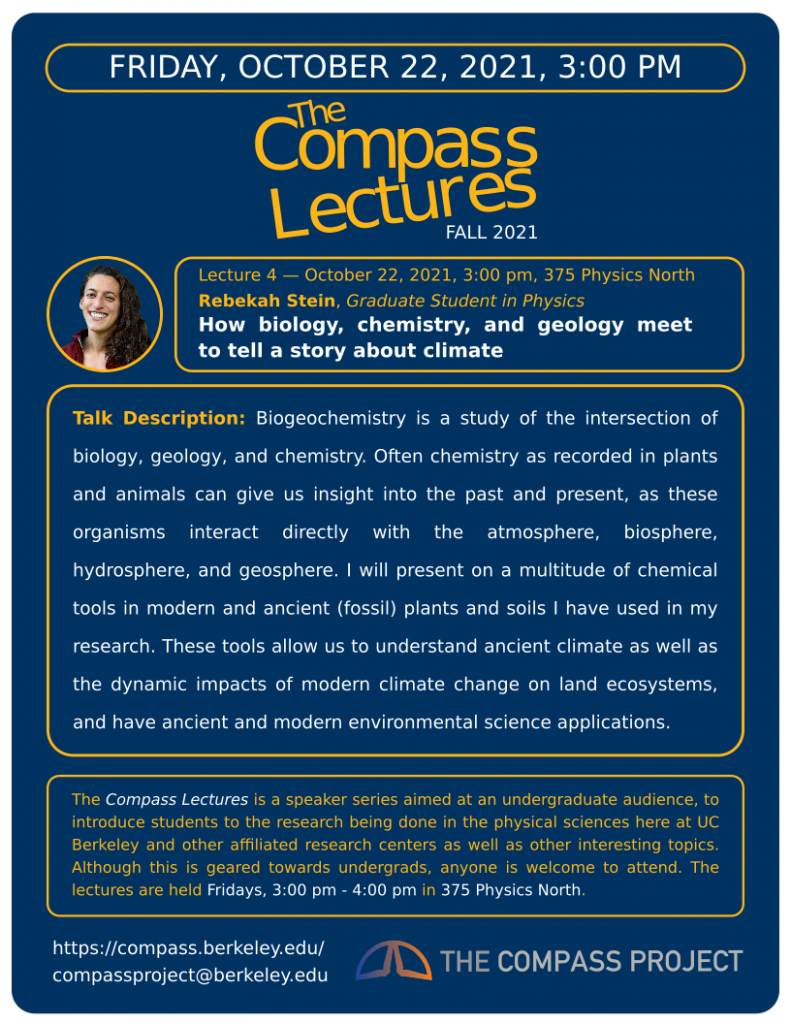
What happens in photoexcited materials in one trillionth of a second?
Yi Lin, Postdoctoral Researcher in the Materials Science Division at LBL
Date & Time: Friday, October 29 2021, 3:00pm – 4:00pm
Location: 375 Physics North
Talk Description: Photoexcited materials are found everywhere in everyday life, from an optical sensor in your phone to the solar panels on rooftops. What decides the functionality of these materials is the behavior of mobile electrons generated in the photoexcitation, such as their transfer, decay and interactions to other physical entities. All these events happen extremely fast. To study them, it requires instrumentations with time resolutions beyond one trillionth of a second. In this lecture, I introduce how researchers at UCB/LBL study photoexcited materials via time-resolved photoemission spectroscopies. By presenting movies of the electrons’ behavior, I would like to take the audience for an exciting journey where what happens in photoexcited materials are witnessed in ultrafast and ultrathin horizons.
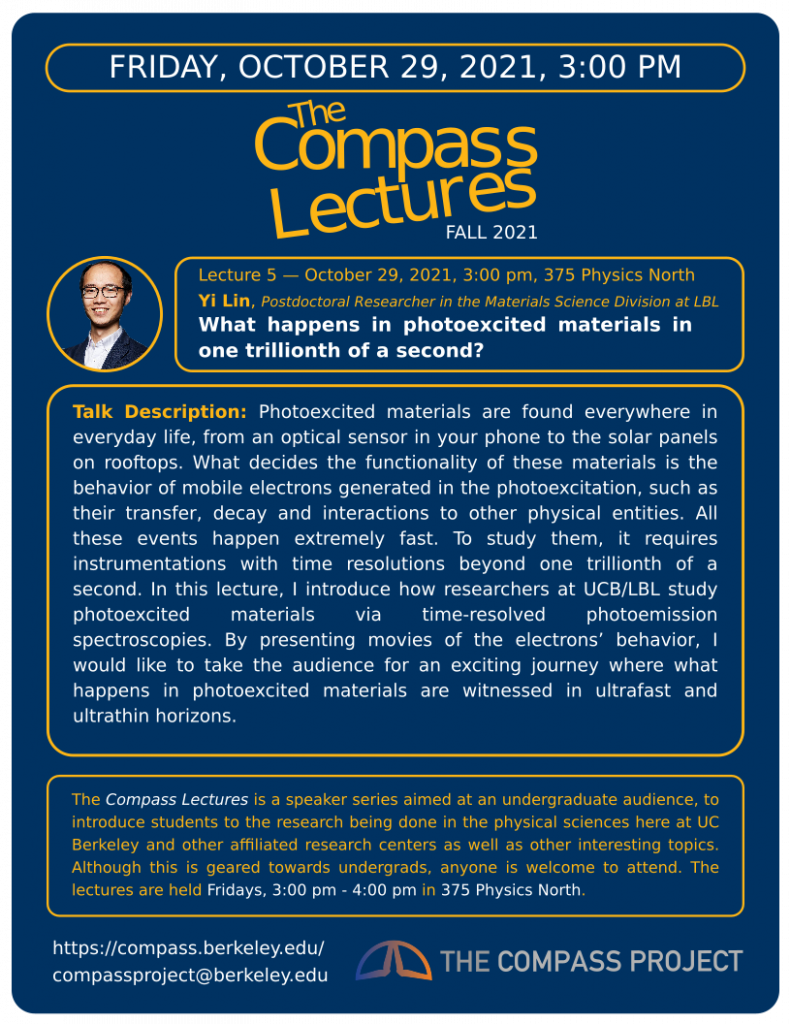
Planetary Diversity: From diamond planets to hot Jupiters
Kanani K. M. Lee, Adjunct Associate Professor of Earth and Planetary Science
Date & Time: Friday, November 5, 2021, 3:00pm – 4:00pm
Location: 375 Physics North
Talk Description: With more than 4000 planets (to date) confirmed outside of our own Solar System, the realization that many are very different from those in our own Solar System lends itself easily to the discussion of plausible planetary compositions and its effect on a planet’s thermochemical evolution. In this talk I’ll bring together astronomical observations, mineral physics experiments and geodynamical models to constrain possible exoplanetary interiors.
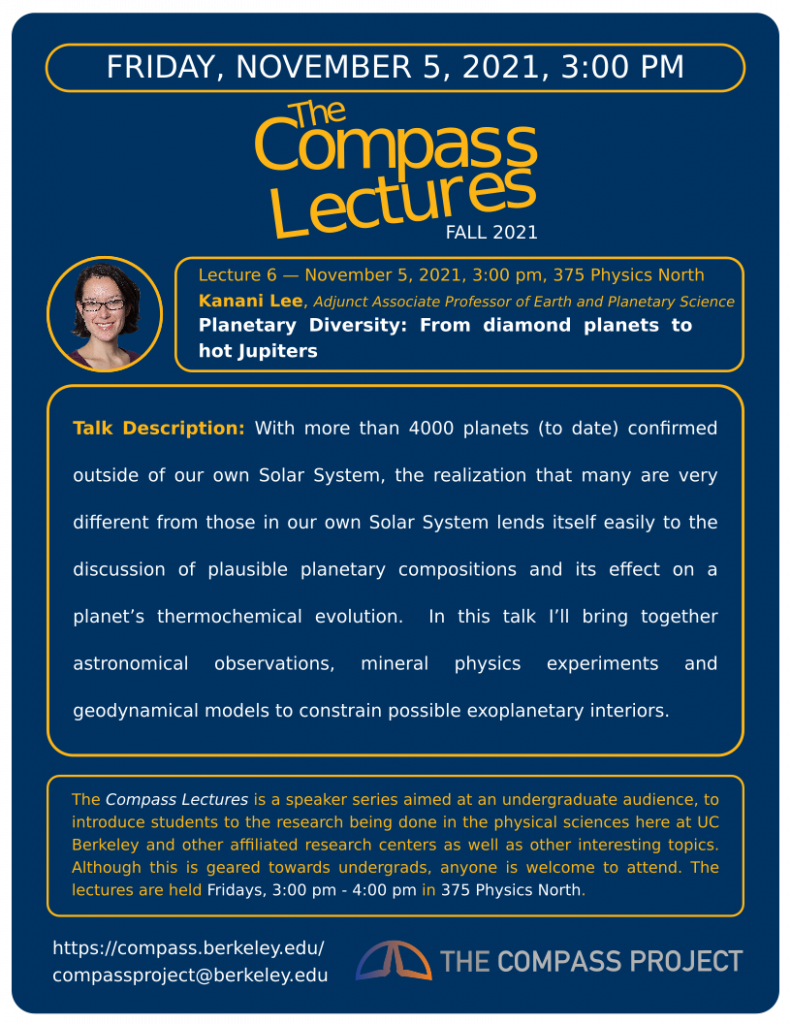
Symmetry Discovery Using Deep Learning
Krish Desai, Graduate Student in Physics
Date & Time: Friday, November 12, 2021, 3:00pm – 4:00pm
Location: 375 Physics North
Talk Description: Symmetries are a fundamental property of functions associated with datasets. A key function for any dataset is the probability density and the symmetries thereof are often referred to as the symmetries of the dataset itself. We provide a rigorous statistical notion of what it means to be a symmetry for a dataset, which involves reference datasets that we call inertial in analogy to inertial frames in classical mechanics. Then, we construct a novel approach to automatically discover symmetries from a dataset using a deep learning method based on an neural network. We show how this model performs on simple examples and provide a corresponding analytic description of the loss landscape. Symmetry discovery may lead to new insights and can reduce the effective dimensionality of a dataset to increase its effective statistics.
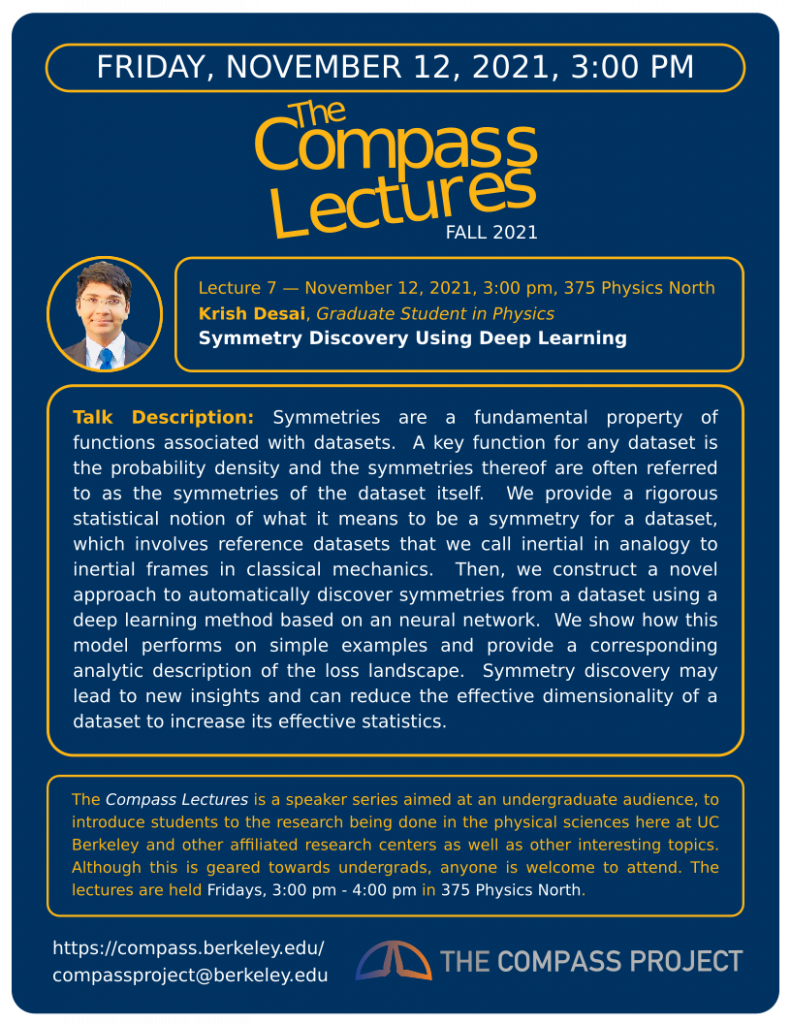
Bringing the heat: what a speed-energy tradeoff in noisy complex systems can tell us about how biomolecules do their jobs
Ben Kuznets-Speck, PhD Candidate in Biophysics
Date & Time: Friday, November 19, 2021, 3:00pm – 4:00pm
Location: 375 Physics North
Talk Description: Biological machines at the nanoscale regulate the rate at which they transition from one long-lived functional state to another by channeling chemical and mechanical energy from external forces and noisy environments. Here we discuss a concrete tradeoff, imposed by statistical physics, between the extent to which such transitions can be sped-up and the work required to do so. We illustrate how such a guiding principle can be put to use in simulations to control and predict the rate of rare events in complex biophysical systems by learning the nonequilibrium forces they naturally feel during such fleeting transitions.
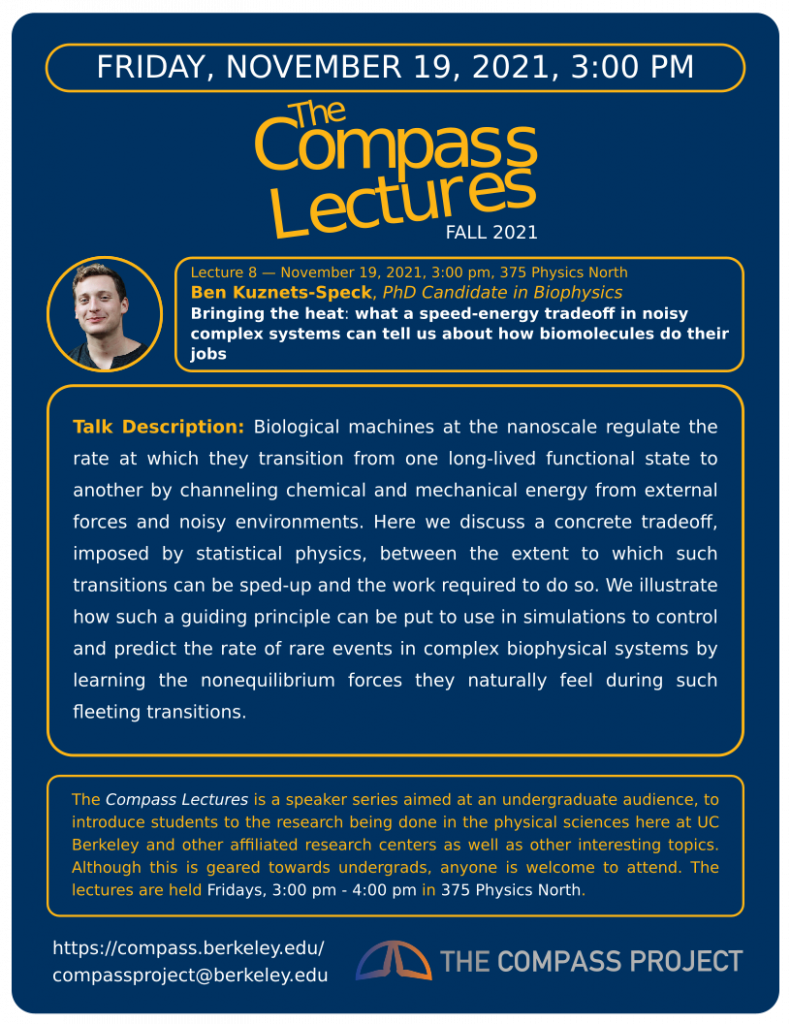
Probing the standard model using atom interferometry
Madeline Bernstein, Graduate Student in Physics
Date & Time: POSTPONED TO NEXT SEMESTER
Location: 375 Physics North
Talk Description: The fine structure constant, also called alpha, is a fundamental constant of the standard model that represents the strength of electromagnetic interactions. Recent discrepancies in its measured value motivate a more precise measurement. Interferometry uses the interference effects of waves to make precise measurements of small quantities. Matterwave interferometry interferes waves of matter rather than light waves, taking advantage of the particle-wave duality of nature. My experiment uses matterwave interferometry to precisely measure alpha by measuring the recoil velocity from an atom absorbing a photon. This is done with an atomic fountain, where atoms are launched into a freefall trajectory, and sent into a quantum superposition of momentum states.